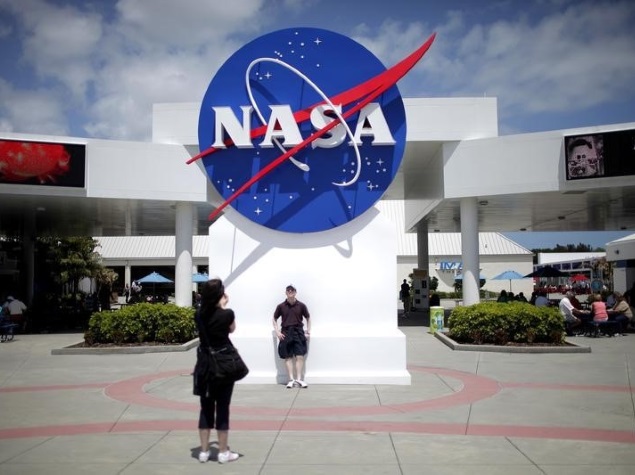- Home
- Science
- Science News
- Nasa Planning Manned Mars Mission for 2030s
Nasa Planning Manned Mars Mission for 2030s

Before astronauts attempt to land on the dusty Martian surface, they must first be prepared to touch down on one of Mars' two tiny moons - Phobos or Deimos - to minimise the risks involved and save money too, the researchers suggested.
Hoppy Price from Nasa's Jet Propulsion Laboratory in Pasadena, California, and colleagues have prepared a mission architecture that gets astronauts to Phobos by 2033 then down to Mars by 2039, Space.com reported.
According to the step-wise approach, astronauts will first establish a base on Phobos, a 16-km-long moon that orbits 6,000 km away from the Martian surface.
This effort would require four launches of Nasa's Space Launch System (SLS) - the largest, most powerful rocket booster ever built and set to launch the unmanned Orion spacecraft in 2018.
The first SLS launch in 2029 will take the astronauts to the Mars orbit in just less than four years.
A second SLS liftoff would carry the Phobos base which could support a crew of four.
The third SLS launch around 2032 would carry a deep-space habitat to the Earth's orbit.
The last SLS liftoff would then send Nasa's Orion capsule and a crew of four up to meet this pre-placed gear.
(Also See: Nasa's Alice on Rosetta Spacecraft Makes Key Discovery About Comet Atmosphere)
It will help take the astronauts to the Mars orbit in a journey lasting 200 to 250 days.
The waiting Phobos Transfer Stage would ferry the astronauts down to the base, in 2033, where the crew would remain for about 300 days.
The astronauts would then head back to Earth and the Phobos habitat would remain on the Martian moon, awaiting possible use by future crews, the report added.
This Phobos base will prove out the method for getting to Mars orbit and back," Price said during a presentation with Nasa's Future In-Space Operations (FISO) working group recently.
"It could happen in our lifetime and will not take a trillion dollars to do it," he added.
In March 2016, Nasa will send a unique Mars lander to explore the Red Planet's deep interior to find clues about how all rocky planets, including the Earth, formed and evolved.
The lander called InSight - Interior Exploration using Seismic Investigations, Geodesy and Heat Transport - is about the size of a car and will be the first mission devoted to understand the interior structure of the Red Planet.
The testing will help in ensuring that InSight can operate and survive in deep-space travel and the harsh conditions of the Martian surface.
The US space agency plans to use the SLS's massive lift capability to carry nearly a dozen nano-satellites to conduct science experiments beyond low-Earth orbit and eventually, Mars.
Catch the latest from the Consumer Electronics Show on Gadgets 360, at our CES 2026 hub.
Related Stories
- Samsung Galaxy Unpacked 2025
- ChatGPT
- Redmi Note 14 Pro+
- iPhone 16
- Apple Vision Pro
- Oneplus 12
- OnePlus Nord CE 3 Lite 5G
- iPhone 13
- Xiaomi 14 Pro
- Oppo Find N3
- Tecno Spark Go (2023)
- Realme V30
- Best Phones Under 25000
- Samsung Galaxy S24 Series
- Cryptocurrency
- iQoo 12
- Samsung Galaxy S24 Ultra
- Giottus
- Samsung Galaxy Z Flip 5
- Apple 'Scary Fast'
- Housefull 5
- GoPro Hero 12 Black Review
- Invincible Season 2
- JioGlass
- HD Ready TV
- Laptop Under 50000
- Smartwatch Under 10000
- Latest Mobile Phones
- Compare Phones
- Red Magic 11 Air
- Honor Magic 8 RSR Porsche Design
- Honor Magic 8 Pro Air
- Infinix Note Edge
- Lava Blaze Duo 3
- Tecno Spark Go 3
- iQOO Z11 Turbo
- OPPO A6c
- Lenovo Yoga Slim 7x (2025)
- Lenovo Yoga Slim 7a
- Lenovo Idea Tab Plus
- Realme Pad 3
- Moto Watch
- Garmin Quatix 8 Pro
- Haier H5E Series
- Acerpure Nitro Z Series 100-inch QLED TV
- Asus ROG Ally
- Nintendo Switch Lite
- Haier 1.6 Ton 5 Star Inverter Split AC (HSU19G-MZAID5BN-INV)
- Haier 1.6 Ton 5 Star Inverter Split AC (HSU19G-MZAIM5BN-INV)







![[Sponsored] Haier C90 OLED TV | Dolby Vision IQ, 144Hz OLED and Google TV in Action](https://www.gadgets360.com/static/mobile/images/spacer.png)









